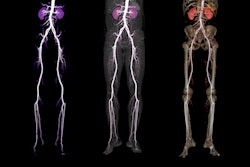
Patients with a fatal course of COVID-19 usually die of sepsis, but how does it occur and, importantly, how should it be managed radiologically? Which modalities tend to work best in these cases?
Prof. Dr. Sebastian Ley is chief physician at the Artemed and Internal Medicine Clinics, Munich South, and chairman of the Thorax Diagnostics Working Group at the German Röntgen Society (Deutsche Röntgengesellschaft, DRG). In this Q&A interview with the DRG, he provides some answers.
Q: What makes sepsis so dangerous?
 Prof. Dr. Sebastian Ley from Munich. Photo courtesy of Internistisches Klinikum München Süd.
Prof. Dr. Sebastian Ley from Munich. Photo courtesy of Internistisches Klinikum München Süd.A: The human body usually fends off infections in a targeted manner through various reactions. It controls these reactions and usually adapts them to the infection process. In the case of sepsis, however, this adaptation no longer works. There is a lack of modulation of the immune responses with unlimited activation of inflammatory processes ("cytokine storm"), a kind of biological overreaction that not only turns against the pathogen but also damages the body as a whole and causes numerous inflammations in those affected. This disrupts the functioning of endothelial cells that line the blood vessels in the human body.
The disorder leads to a leak in the capillaries. Pathogens enter the bloodstream leading to a generalized and worsening edema. Blood clots increasingly form in the vessels of those affected and at the same time their bodies lose the ability to dissolve blood clots on their own. Overall, this leads to a globalized organ dysfunction and ultimately to multiorgan failure.
In 2020, the German Sepsis Society published an S3 guideline which defined sepsis or septic shock as arterial hypotension that persists despite adequate volume therapy and which requires therapy with vasopressors in order to achieve a mean arterial blood pressure of ≥ 65 mmHg. At the same time, the lactate value in the serum must be > 2 mmol/l.
Q: Is it possible to medically prevent an infection from developing into sepsis?
A: Sepsis is caused by bacteria, fungi, parasites, and viruses in decreasing frequency. The most important measure is to combat infection at an early stage, especially locally, for example in a wound. For other infections, optimal therapy with antibiotics is essential. Despite these measures, sepsis can occur because the human body's immune response to an infection cannot be predicted.
Q: So far, there are no specific therapies for sepsis. Does that factor alone encourage early diagnoses and timely start to medical treatment, which often has to be intensive care medicine?
A: If antimicrobial substances cannot combat the diseased organisms, sepsis can currently only be treated symptomatically. Medical attempts to combat numerous inflammations in the body, for example using cytokine antagonists, so far have failed. The only specific starting point is to combat the causative infection, which must be identified before it can be specifically treated, and this is where radiological methods are used. Clinically, a diagnostic score ("quick sequential organ failure assessment" (qSOFA) score) is used to assess whether sepsis is present. The qSOFA-Score uses the following variables for risk assessment: changed mental status, systolic blood pressure <100 mmHg or a respiratory rate ≥ 22 / min. Compared to a qSOFA score of 0 or 1 point, patients with a qSOFA score of 2 or 3 points have a 3- to 14-fold increased risk of dying. Since, in the event of sepsis, the pathogenic germs are in the bloodstream, taking blood cultures is the most important clinical measure to secure the germ. A third to half of all patients die from sepsis. That is around 70,000 people a year in Germany alone. This makes sepsis the third most common cause of death in Germany after cardiovascular diseases and cancer.
Q: What procedures do radiologists use to diagnose incipient or already developed sepsis?
A: The most common pathogens that cause septic shock are gram-negative bacteria and gram-positive microorganisms. The location where the germ specifically organizes and spreads can be localized using radiological and nuclear medicine methods. The germs can quickly then be treated surgically or interventionally. The high mortality of the disease requires rapid diagnosis.
Radiologists mainly use CT as a widely available and established technology. Acquisition with intravenously injected contrast medium is recommended: the upper abdomen and pelvis in the arterial phase followed by the skull, neck, thorax, and upper abdomen/pelvis in the portal vein. If the focus of the infection in the patient's abdomen is suspected, a late phase (3-5 min) can also be helpful. Typical and established signs indicate inflammation and the severity of the hemodynamic changes. If this does not reveal a clear source of infection, an MRI can also be helpful, e.g., to reliably detect cerebral infections or spondylodiscitis.
FDG-PET imaging is highly suitable for clarifying the location of the infection, as this technology also reliably detects infected cardiac pacemakers and defibrillators, for example.
Q: What direct or indirect information can radiologists use to infer a sepsis focus in a patient's body or the cause of the sepsis?
A: The most common locations of infections are pulmonary, but they're also to be found in organs such as the heart, kidneys, liver, or the intestine. The central nervous system and patients' soft tissue can be affected. Therefore, radiologists must carefully assess these areas. Above all, clinical information on the possible focus of infection is essential in order to differentiate between primary and secondary changes. CT usually allows the source of infection to be localized through the well-known changes. In addition to the CT and PET/CT techniques already mentioned, ultrasound is also used, which is very useful in the case of inflammation of the kidneys or the heart.
Q: People suffering from sepsis must receive intensive radiological follow-up during the acute phase and afterward. Can you describe what this care involves, including aftercare?
A: During the acute sepsis phase, radiological exams are usually focused on assessing the lungs, since many patients suffer from acute lung failure in addition to multiple organ failure. In the course of the disease, however, primarily myopathic or neuropathic changes develop, which only slowly recede. Therefore, radiology is of little importance in the postacute phase.
Q: Can people protect themselves from sepsis?
A: The prevention of infections is of the utmost importance. You can generally protect yourself from infection through general hygiene as well as careful handling of wounds and, for example, infected insect bites. At the same time, chronic diseases such as diabetes mellitus should be treated. Vaccinations are an essential part of prevention in order to be able to combat infections in the body in a targeted manner.
Q: Studies show that around a quarter of all patients who contract COVID-19 develop sepsis. Could you explain this?
A: It is true that around 25% of COVID-19 patients who require hospital treatment go into septic shock. Most deaths from COVID-19 are associated with sepsis. The COVID-19 disease is a viral disease that cannot be treated specifically. Therefore, the infection cannot be quickly contained with medication. As part of the massive inflammation caused by the virus, the cytokine storm and global inflammation/sepsis occur in some patients. Various data show liver damage in these patients in 30% of the cases, acute kidney failure in 20%, and an impaired immune response in 75%. These persistent effects on the immune system appear to be a major cause of long-COVID syndrome.
Q: You are co-author of the recommendations for doctors on "Chest imaging and structured CT diagnosis in COVID-19 patients" by the DRG. Do doctors also apply these recommendations to patients who are sick with COVID-19 and who have been diagnosed with sepsis?
A: The recommendations for structured diagnosis and severity assessment by the DRG are an essential aspect for assessing the disease as early as possible. As described, patients severely affected by COVID-19 are usually at greater risk of developing sepsis. This information is therefore important for increased vigilance on the part of intensive care physicians to monitor patients and to detect the onset of sepsis at an early stage. It is also important to record the comorbidities in the CT, as this makes it possible to assess the overall disease burden of the patient. If sepsis has occurred for a previously unexplained cause, CT is the most suitable method for identifying the focus. Here, too, assessment of, specifically, systematic assessment of the lungs plays an important role.
Editor's note: This is an edited version of a translation of an article published in German online by the DRG on 9 August 2021. Translation by Frances Rylands-Monk. To read the original version, go to the DRG website.



















